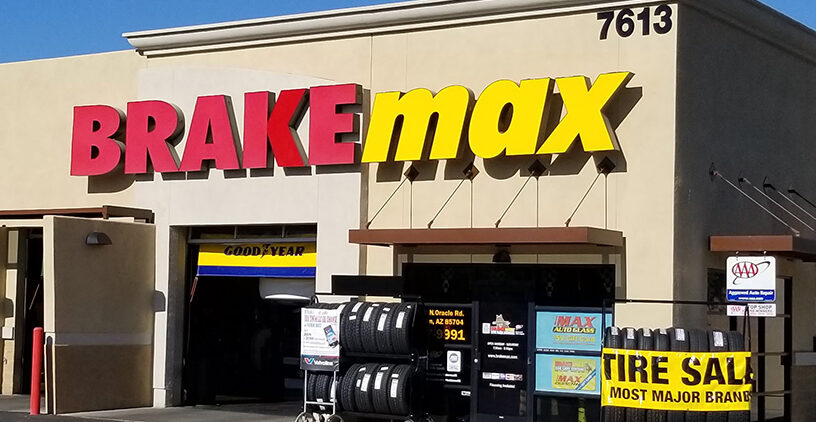Ultimate Tucson Transmission Shop Guide
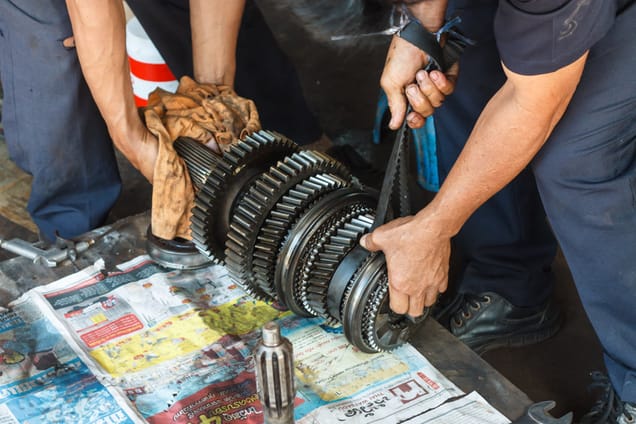
Most drivers know that the transmission is the component in their car or truck that shifts the gears. A car’s automatic transmission changes gears automatically for the driver while the car is in motion. However, in a car with a manual transmission, the driver must press a clutch pedal to unlock the gears and then change one gear into the next by moving a gear shift inside the car manually.
The most common type of automatic transmission uses a hydraulic system that locks and unlocks a series of gears as the car shifts for you. Manual transmissions operate with a friction clutch.
Beyond those basic facts, it’s often left up to a local transmission shop to service the vehicle’s transmission. A mechanic experienced in working on transmissions is the best choice you can make.
But first, it’s up to you to make sure it is maintained properly to avoid a costly transmission repair.
Types of Transmissions
Most drivers know the two main types of transmissions: Automatic and manual. But there are two more. And to properly maintain your own car’s transmission, it’s important that you know which one it is.
Automatic Transmission
This transmission shifts through the gears for the driver using a torque converter, gearset, and clutches or bands. However, some automatics give the driver some manual control when needing additional power for upshifts and downshifts. This is sometimes called a shiftable automatic, Tiptronic, or AutoStick.
Manual Transmission
In this type, the driver selects the gears manually by using a gear selector and clutch. It is also called a stick shift or standard transmission. There are many advantages to manual transmission because it’s cheaper and easier to repair than an automatic one.
Automated Manual Transmission
The automated manual uses a mechanical clutch, but the action is not controlled by the driver pushing the clutch. It is automated through electronic or hydraulic controls. Another name is direct shift gearbox or sequential manual gearbox. It allows for fully automatic forward gear shifts through the gear selector or buttons or paddles on the steering wheel.
Continuously Variable Transmission
The continuously variable transmission (CVT) has a continuously variable drive ratio. There are no stepped gears. The purpose is to maintain steady acceleration without pauses for gear changes. This keeps the engine at its highest power range, which increases efficiency and gas mileage.
Transmission Fluid and Your Car
One of the most common questions by vehicle owners about their transmission concerns changing the fluid. It isn’t a system that many drivers pay much attention to until it’s too late. Allowing your car to run low on transmission fluid can cause improper shifting, or it can stop shifting altogether. Here are some things to remember so that your car’s transmission stays in good working order and keeps you on the road!
Automatic transmission fluid is purposely made in bright colors so that you can tell the difference between this fluid and engine oil. Transmission fluid is often red but is now also created in blue/green, purple, or amber. It’s important to know what you are looking at as you work to keep your car and all its systems in top working order.
Transmission Fluid Changes in Tucson
An obvious question is if this fluid needs to be changed like engine fluid and how often. Get that owner’s manual out again! That is your best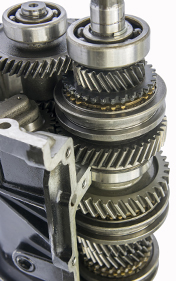 source to check first. But remember, transmission fluid should never burn off like engine oil does. Any leak that is a red (or another bright color) puddle under your car points to a transmission leak, usually under the middle or front of the vehicle. Then, your car will need the system checked for leaks and the fluid replenished.
source to check first. But remember, transmission fluid should never burn off like engine oil does. Any leak that is a red (or another bright color) puddle under your car points to a transmission leak, usually under the middle or front of the vehicle. Then, your car will need the system checked for leaks and the fluid replenished.
The intervals for changing the transmission fluid do vary a great deal. Some vehicles might need a fluid change at 30,000 miles, while others won’t need that service until 100,000 miles. So, a fluid change might be necessary if you keep a car for an extended period or if you purchase a used car that already has high mileage on it. But if you tend to change cars regularly, you may never need a transmission fluid change.
Some newer cars have fitted automatic gearboxes. The transmission is sealed almost completely, and the fluid is meant to last the lifetime of the car. However, some CVTs do need the fluid changed.
So, changing the transmission fluid can be a confusing issue for vehicle owners. If you add this maintenance check to your other regularly scheduled service visits to BRAKEmax, you will have it covered! Getting the fluid checked will cost much less than getting the transmission repaired or even replaced simply from neglect.
Transmission Fluid Flushes in Tucson
Keep in mind that transmission fluid doesn’t normally burn off. Its job is to keep the mechanical parts cool and lubricated, whether the transmission is manual or automatic. If any parts become damaged or worn down (which is where the 100,000-mile standard comes in), the fluid can become contaminated. A transmission flush would then be necessary.
Otherwise, the only way for transmission fluid to get low is for the car to develop a leak, which would then need to be fixed. That could involve a flush. Or maybe a recall involving the transmission is issued for your vehicle. The fluid might be flushed during the process of addressing the recall specifics.
And, just to be clear, there is a difference between draining and refilling the fluid and doing a power flush. The power flush needs to be done infrequently because it can dislodge sludge and other particles that can contaminate the clean fluid. But whether it is a drain or a flush, follow the directions and frequency recommended in your owner’s manual. If this is done too often, you are simply spending time and money that isn’t necessary.
Manual Transmission and Fluid
Yes, manual transmissions use fluid, too, although the fluid needed can differ from car to car. Make sure you are using the right kind for your car. If you don’t, performance, as well as longevity, can be affected. And CVT vehicles have different needs because that system works using a belt or pulley system to handle gear ratios. This is a good time to consult with the transmission specialists at our Tucson auto shops.
DIY Transmission Fluid Changes
Modern transmissions are sealed tightly and require a computer set up to read temperatures and other data. This generally isn’t a job for a DIY mechanic.
The biggest obstacle is access to the transmission. It’s a job that requires ramps, jack stands, or a lift. The fill plug is difficult to remove, also.
Types of Transmission Fluid
There are several kinds of transmission fluids:
Automatic Transmission Fluid
Also known as "AT Fluid", this is used in cars with automatic transmissions and some modern manual transmissions. AT fluid assists with lubricating the gears, torque and clutch friction operation, valve body function, brake band friction, and cooling the transmission.
Manual Transmission Fluid
This is used in some older cars. It is a heavier fluid at 75W to 140W and is never used in automatic transmission vehicles.
Traditional Transmission Fluid
This is made from crude oil along with hydrocarbons according to specifications for different vehicles.
Synthetic Transmission Fluid
This is created through several chemical reactions. It is less likely to break down, oxidize, or thin at high temperatures.
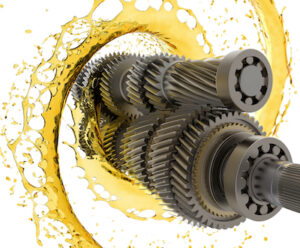
Preventative Transmission Maintenance Is Critical
Pull out your car’s owner’s manual and find out what is recommended as a regular maintenance schedule for your vehicle. Ask your BRAKEmax service staff to add this preventative check to your other maintenance visits. By combining a number of these maintenance visits, you save time and money by heading off more serious problems later. This is one of the best ways to keep your transmission in top working order for as long as possible without repairs.
Another aspect of protecting the transmission in your car or truck also rests with you, the owner of the vehicle, and some actions you can take on a routine basis.
- Check the transmission fluid yourself on a regular basis. It’s the same process as checking the oil on most cars. Specifically, put your car in park, locate the dipstick, and check the reading. A low level might indicate a leak, which is serious. The fluid should be a bright, clear color, usually red. If it is cloudy and dark, it should be investigated. A burnt smell means you should get the car to your shop as soon as possible. Any of these red flags can turn into expensive, time-intensive repairs quickly.
- If you add transmission fluid yourself, check your owner’s manual first. It will state which fluid to use.
- Make sure your engine’s cooling system is in top working order. It also cools the transmission fluid pumping into the gearbox.
- Check the owner’s manual again for how often to get a transmission flush. In general, it should be done once a year, but that depends on the vehicle’s normal operating temperature. How much you drive the car also affects this, so leave it to your transmission specialist to determine when to change the transmission fluid.
- Allow some warm-up time for your engine before driving it, especially in the winter cold.
- Don’t drive with your foot on the brake. If you do, you are putting unnecessary pressure on the transmission as well as the engine.
- If parking on a hill, use the emergency brake.
- Many people don’t consider that riding longer than necessary with a spare tire on one of the wheels is bad for the transmission, but it is. It puts strain on many systems in the vehicle, including the transmission.
- If your car’s transmission has a filter, it should be changed on a regular basis. Check the owner’s manual to find out if your make/model has a filter. Most newer cars don’t, but there is only one way to know, so check the manual.
- Towing anything with your vehicle puts strain on the transmission. Avoid towing heavy loads, especially in hot weather.
- Don’t ignore the “check engine” light! The light can indicate problems with your transmission as well as your engine. If it is the transmission, the light means that the fluid is hotter than normal. That is never good, so get the car to your auto shop as soon as possible.
Finally, another reminder is to have the transmission inspected annually by our Tucson mechanics for leaks and other abnormalities. It’s the best way to keep your vehicle’s transmission healthy!
Common Problems with Transmissions
How do you know what a transmission problem looks like exactly? Although many systems in vehicles have similar trouble signs, here are some clues to watch for. Then get the car checked out to pinpoint the exact cause or these:
- Leaks under the car
- Clutch failure
- Strange noises during gear changes
- Vibrations or grinding during gear changes
- Gear failure
- Gear pops in and out
- Gear reacts slowly or squishy clutch
- Burning smell
- Automatic transmission shakes
- Check engine light illuminates
- Car overheats
- Noisy when the car is in neutral
The best advice? Don’t ignore signs like these! The situation won’t correct itself; make an appointment at BRAKEmax, and have a professional diagnose the problem.
The Cost of Transmission Repair and Replacement
Transmission repairs can run an average of $900, with a range from $300 to $1500. Labor costs for transmission work are high, often running between $1000 and $2000.
If the repair is a simple leak, the cost is relatively inexpensive. However, a solenoid, along with the labor costs to install it, can be prohibitive. At some point, the cost is so high to repair a transmission that it is sometimes better to go with a more inexpensive rebuild of the system.
It is a difficult decision to make. Here are some factors to consider:
- If you have kept the vehicle maintained properly, the cost of the repair is generally less than a car that has a lot of wear and tear.
- A manual transmission is less expensive to repair than an automatic transmission.
- Imported vehicles are more expensive to repair.
- The age of a car must be weighed against the cost of the repair bill plus labor.
- The geographic location of the repair shop affects the price. Plus, every auto repair shop has different rates for services performed.
Once you know what repair your car’s transmission needs, you have more decisions to make. The following are other options, although there are costs involved with them, too:
- You can choose to purchase a used or second-hand transmission which will run between $800 and $1500.
- A rebuilt transmission runs between $1100 and $2800.
- A remanufactured transmission ranges from $1300 to $3400.
These transmissions can sometimes be found at parts resale lots. And keep in mind that a rebuilt transmission can be close to the cost of a new transmission. It depends on the amount of damage that is involved.
A final word on rebuilding a transmission is that it is a labor-intensive job with multiple steps involved. The transmission in the car first has to be disassembled so the problem can be determined. Then all the broken parts must be replaced, along with the transmission fluid. Trouble codes have to be validated and sensors replaced. It is easy to see how the labor costs can soon soar.
Finally, if the car has become a liability due to numerous failing systems, it may be time to sell it. You can sell it for parts at junkyards and buy a newer car with fewer problems.
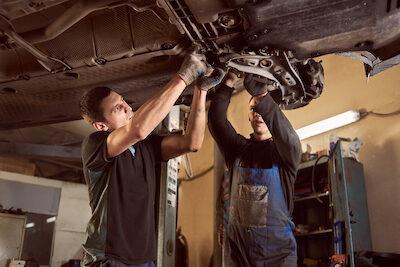
Transmission Repair in Tucson
The biggest factor in repair time is getting parts. These parts are not always kept in an auto shop, so they have to be ordered. Some of these parts come from overseas, so shipping can take time.
Parts for certain types of vehicles can also take more time to get to the repair shop. Those needed for CVT transmissions, luxury cars and imported vehicles, and commercial and heavy-duty trucks can all take additional time to be ordered and shipped to the shop.
During this time, your car will probably not be available to you. Check your auto insurance policy to see if it provides rental car reimbursement.
Let Our Tucson Transmission Mechanics Help!
Even though it isn’t a high visibility system in your vehicle, your transmission is critical for more than shifting gears. And a problem in your transmission can bring your car to a halt—literally—in a short period of time. Repairs and replacements are expensive and time-consuming. Let BRAKEmax help you keep this system in top working order. And don’t forget our money-saving coupons, too!


